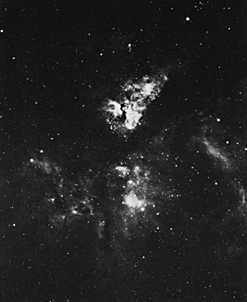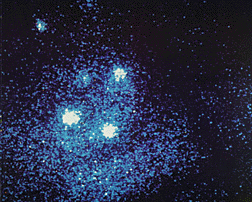Einstein image of the Eta Carinae NebulaThe Eta Carinae Nebula is a large and complex cloud of gas criss-crossed with dark lanes of dust some 6,500 light years from the Earth. Buried deep within this cloud are many bright young stars and a very peculiar variable star, Eta Carinae. The Einstein X-ray observation of the Eta Carinae Nebula proved to be remarkably like the optical pictures. Not only could the star Eta Car be seen and the dark dust lanes in the nebula identified, several other sources of X-ray emission were detected. These points apparently correspond to O stars: hot, young objects still in their early evolutionary stages. Normally these stars are buried so deep in the dust and gas of the nebula that they are seen only by the infrared radiation from the surrounding cocoons of dust. Their detection in X-rays is somewhat surprising. Some hitherto unknown mechanism, perhaps magnetic bubbles in their atmospheres, must be allowing X-ray radiation to escape. The O stars of Eta Carinae represent an entirely new and unexpected class of objects observable to X-ray astronomers. Visible light image from Cerro Tololo Interamerican Observatory. Einstein X-ray image from Seward (SAO). Both images are reproduced from the pamphlet "High Energy Astronomy Observatory", NASA publication EP-167.
IMAGES |
By Mission |
Stars |
HEASARC Home | Observatories | Archive | Calibration | Software | Tools | Students/Teachers/Public Last modified: Thursday, 26-Jun-2003 13:48:45 EDT HEASARC Staff Scientist Position - Applications are now being accepted for a Staff Scientist with significant experience and interest in the technical aspects of astrophysics research, to work in the High Energy Astrophysics Science Archive Research Center (HEASARC) at NASA Goddard Space Flight Center (GSFC) in Greenbelt, MD. Refer to the AAS Job register for full details. |



